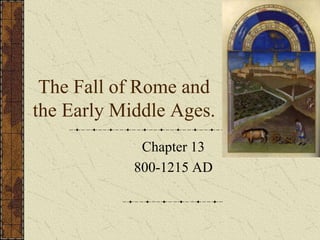The document discusses the fall of the Western Roman Empire and the emergence of feudalism in medieval Europe. It describes how Germanic tribes like the Goths, Vandals, and Franks invaded the declining Roman Empire beginning in the 4th century AD. These invasions contributed to the fall of the Western Roman Empire in 476 AD. After the fall, cities declined as people fled to the countryside for safety. Society became organized around manors and a feudal system developed, with kings granting land to lords in exchange for loyalty and military service. Lords then granted land to knights who protected local peasants. Charlemagne later conquered much of Western Europe and was crowned Holy Roman Emperor on Christmas Day 800,



















































![‘He [the Conqueror] harried the land and burnt homes to
ashes. Nowhere else had William shown such cruelty. In
his anger he commanded that all crops and herds, chattels
and food of every kind, should be brought together and
burned to ashes with consuming fire, so that the whole
region north of the Humber might be stripped of all means
of sustenance.
In consequence, so serious a scarcity was felt in England,
and so terrible a famine fell upon the humble and
defenceless populace, that more than 100,000 Christian folk
of both sexes, young and old, perished of hunger’
Genocide in Yorkshire](https://image.slidesharecdn.com/presentation13-150107110959-conversion-gate01/85/Presentation13-52-320.jpg)






































